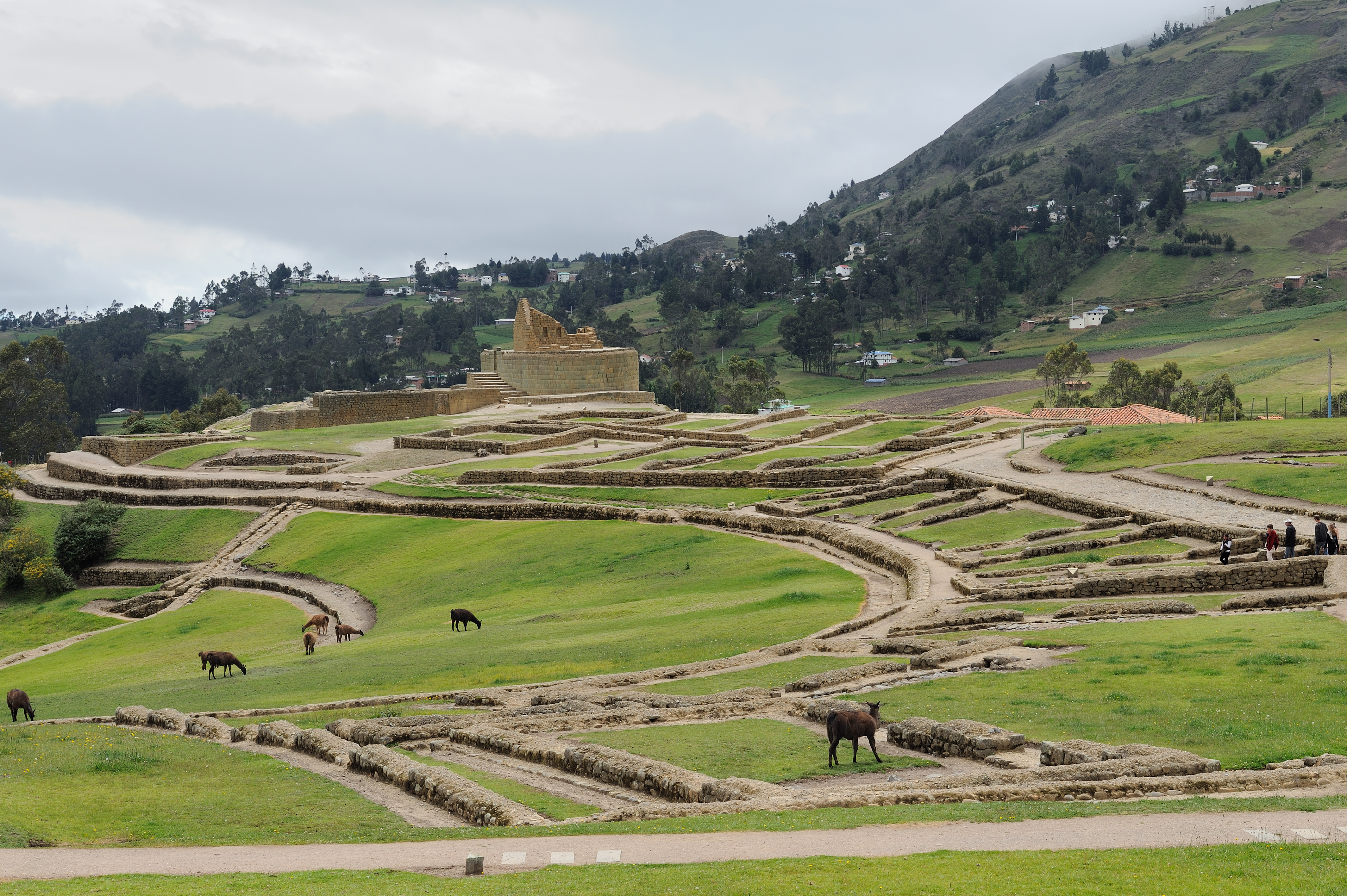|
Ingapirca Archaeo 01
Ingapirca (Kichwa: ''Inka Pirka'', "Inca wall") is a town in Cañar Province, Ecuador, and the name of the older Inca ruins and archeological site nearby. These are the largest known Inca ruins in Ecuador. The most significant building is the Temple of the Sun, an elliptically shaped building constructed around a large rock. History This area had long been settled by the Cañari indigenous people, who called it ''Hatun Cañar.'' As the Inca Empire expanded into southern Ecuador, the Inca Túpac Yupanqui encountered the Cañari "Hatun Cañar" tribe. He had difficulties in conquering them. He used different political strategies, marrying the Cañari princess and improving the Cañari city of ''Guapondelig,'' calling it Tumebamba or Pumapungo (present-day Cuenca). The Inca and Cañari decided to settle their differences and live together peacefully. The astronomical observatory was built under Inca Huayna Capac. The Inca renamed the city as Ingapirca and kept most of their distin ... [...More Info...] [...Related Items...] OR: [Wikipedia] [Google] [Baidu] |
Cañar Province
Cañar () is a province in Ecuador. The capital is Azogues. At the time of census 2010 the province had a population of 225,184. It contains the 16th-century ruins of Ingapirca, the best-known Inca settlement in Ecuador and a product of their conquest of the indigenous Cañari. Cantons The province is divided into 7 cantons. The following table lists each with its population at the time of the 2001 census, its area in square kilometres (km²), and the name of the canton seat or capital. Statoids.com. Retrieved 4 November 2009. 3 See also * * |
Aqueduct (water Supply)
An aqueduct is a watercourse constructed to carry water from a source to a distribution point far away. In modern engineering, the term ''aqueduct'' is used for any system of pipes, ditches, canals, tunnels, and other structures used for this purpose. The term ''aqueduct'' also often refers specifically to a bridge carrying an artificial watercourse. Aqueducts were used in ancient Greece, ancient Egypt, and ancient Rome. The simplest aqueducts are small ditches cut into the earth. Much larger channels may be used in modern aqueducts. Aqueducts sometimes run for some or all of their path through tunnels constructed underground. Modern aqueducts may also use pipelines. Historically, agricultural societies have constructed aqueducts to irrigate crops and supply large cities with drinking water. Etymology The word ''aqueduct'' is derived from the Latin words (''water'') and (''led'' or ''guided''). Ancient aqueducts Although particularly associated with the Romans, aqueducts we ... [...More Info...] [...Related Items...] OR: [Wikipedia] [Google] [Baidu] |
Buildings And Structures In Cañar Province
A building, or edifice, is an enclosed structure with a roof and walls standing more or less permanently in one place, such as a house or factory (although there's also portable buildings). Buildings come in a variety of sizes, shapes, and functions, and have been adapted throughout history for a wide number of factors, from building materials available, to weather conditions, land prices, ground conditions, specific uses, prestige, and aesthetic reasons. To better understand the term ''building'' compare the list of nonbuilding structures. Buildings serve several societal needs – primarily as shelter from weather, security, living space, privacy, to store belongings, and to comfortably live and work. A building as a shelter represents a physical division of the human habitat (a place of comfort and safety) and the ''outside'' (a place that at times may be harsh and harmful). Ever since the first cave paintings, buildings have also become objects or canvasses of much artisti ... [...More Info...] [...Related Items...] OR: [Wikipedia] [Google] [Baidu] |
Archaeological Sites In Ecuador
Archaeology or archeology is the scientific study of human activity through the recovery and analysis of material culture. The archaeological record consists of Artifact (archaeology), artifacts, architecture, biofact (archaeology), biofacts or ecofacts, archaeological site, sites, and cultural landscapes. Archaeology can be considered both a social science and a branch of the humanities. It is usually considered an independent academic discipline, but may also be classified as part of anthropology (in North America – the four-field approach), history or geography. Archaeologists study human prehistory and history, from the development of the first stone tools at Lomekwi in East Africa 3.3 million years ago up until recent decades. Archaeology is distinct from palaeontology, which is the study of fossil remains. Archaeology is particularly important for learning about prehistoric societies, for which, by definition, there are no written records. Prehistory includes ove ... [...More Info...] [...Related Items...] OR: [Wikipedia] [Google] [Baidu] |
Populated Places In Cañar Province
Population typically refers to the number of people in a single area, whether it be a city or town, region, country, continent, or the world. Governments typically quantify the size of the resident population within their jurisdiction using a census, a process of collecting, analysing, compiling, and publishing data regarding a population. Perspectives of various disciplines Social sciences In sociology and population geography, population refers to a group of human beings with some predefined criterion in common, such as location, race, ethnicity, nationality, or religion. Demography is a social science which entails the statistical study of populations. Ecology In ecology, a population is a group of organisms of the same species who inhabit the same particular geographical area and are capable of interbreeding. The area of a sexual population is the area where inter-breeding is possible between any pair within the area and more probable than cross-breeding with i ... [...More Info...] [...Related Items...] OR: [Wikipedia] [Google] [Baidu] |
Puñay
Cerro Puñay is a volcanic cone in the Chunchi Canton of Ecuador. Possible structure Since 2002 it has become a tourist attraction, based on the claim that at the top there is an ancient structure, referred to variously as a temple and a pyramid, possibly shaped like a Macaw. An alleged Quechua myth about a lost pyramid containing golden artifacts located somewhere in the Ecuadorian highlands supposedly lured both archeologists and grave robbers to the area in search of Puñay. In 2002 Christian Aguirre, a student in the School of Ecotourism in the University Politecnica de Chimborazo said that it had the formation of a giant Macaw, a bird sacred to all Andean Cultures. In an interview Christian said with regards to the many holes in the pyramid "These holes were made about 50 to 70 years ago by gringos. Nobody knows what they took but many people here say there used to be a lot of gold" In 2003, Eudoro Flores, the former mayor of the nearby city of Chunchi, was noted as s ... [...More Info...] [...Related Items...] OR: [Wikipedia] [Google] [Baidu] |
Mapa De Ingapirca
Mapa or MAPA may refer to: People * Alec Mapa (born 1965), American actor, comedian and writer * Dennis Mapa (born 1969), Filipino economist and statistician * Jao Mapa (born 1976), Filipino actor * Placido Mapa Jr. (born 1932), Filipino businessman, economist, and government official * Suraj Mapa (born 1980), Sri Lankan actor * Victorino Mapa (1855–1927), Filipino chief justice and government official Other uses * "Mapa" (song), a 2021 song by SB19 * Mexican American Political Association * Mapa (publisher), an Israeli subsidiary of Ituran * Mapa Group, a Turkish conglomerate * Mapa, a company producing latex gloves that merged with Hutchinson SA in 1973 * Most Affected People and Areas, a climate justice concept See also * * Mappa (other) is a Japanese animation studio headquartered in Suginami, Tokyo. Founded in 2011 by Madhouse (company), Madhouse co-founder and producer Masao Maruyama (film producer), Masao Maruyama, it has produced anime works i ... [...More Info...] [...Related Items...] OR: [Wikipedia] [Google] [Baidu] |
El Tambo Canton
El Tambo is one of seven cantons located in Cañar Province, Ecuador. It is situated along the PanAmerican highway in a valley across from the larger town of Cañar. The population of El Tambo is a mix of mestizo and indigenous Cañari. About 30 minutes out of El Tambo is the town of Ingapirca named after the Incan The Inca Empire (also known as the Incan Empire and the Inka Empire), called ''Tawantinsuyu'' by its subjects, (Quechua for the "Realm of the Four Parts", "four parts together" ) was the largest empire in pre-Columbian America. The admin ... ruins that are there. The ruins of Ingapirca are the largest Incan ruins in Ecuador. External linksEl Tambo travel destination Cantons of Cañar Province {{Ecuador-geo-stub ... [...More Info...] [...Related Items...] OR: [Wikipedia] [Google] [Baidu] |
Cuenca, Ecuador
Santa Ana de los Cuatro Ríos de Cuenca, commonly referred to as Cuenca (Kichwa: ''Tumipampa'') is the capital and largest city of the Azuay Province of Ecuador. Cuenca is located in the highlands of Ecuador at about above sea level, with an urban population of approximately 329,928 and 661,685 inhabitants in the larger metropolitan area. The center of the city is listed as a UNESCO World Heritage Site due to its many historical buildings and its historical importance as an agricultural and administrative center. History “The plateau is a place treasured by empires," comments Jeffrey Herlihy-Mera. "The Cañari then Inca and then Spanish occupied the region in the last two millennia, each renaming it in their own language. Now the capital city is called Cuenca and the province Azuay.” According to studies and archeological discoveries, the origins of the first inhabitants go back to the year 8060 BC in the Cave of Chopsi. They were hunters, hunting everything the Páramo ... [...More Info...] [...Related Items...] OR: [Wikipedia] [Google] [Baidu] |
Fermented Drink
This is a list of fermented foods, which are foods produced or preserved by the action of microorganisms. In this context, fermentation typically refers to the fermentation of sugar to alcohol using yeast, but other fermentation processes involve the use of bacteria such as lactobacillus, including the making of foods such as yogurt and sauerkraut. Many fermented foods are mass produced using industrial fermentation processes. The science of fermentation is known as zymology. Many pickled or soured foods are fermented as part of the pickling or souring process, but many are simply processed with brine, vinegar, or another acid such as lemon juice. __TOC__ Fermented foods Fermented beans and seeds Fermented cheeses Most cheeses (all but fresh cheeses) are fermented as part of their production. Fermented condiments Fermented creams and yogurts Fermented grains and grain-based foods Fermented fruits and vegetables Fermented meat and seafood ... [...More Info...] [...Related Items...] OR: [Wikipedia] [Google] [Baidu] |
Solstice
A solstice is an event that occurs when the Sun appears to reach its most northerly or southerly excursion relative to the celestial equator on the celestial sphere. Two solstices occur annually, around June 21 and December 21. In many countries, the seasons of the year are determined by the solstices and the equinoxes. The term ''solstice'' can also be used in a broader sense, as the day when this occurs. The day of a solstice in either hemisphere has either the most sunlight of the year (summer solstice) or the least sunlight of the year ( winter solstice) for any place other than the Equator. Alternative terms, with no ambiguity as to which hemisphere is the context, are " June solstice" and "December solstice", referring to the months in which they take place every year. The word ''solstice'' is derived from the Latin ''sol'' ("sun") and ''sistere'' ("to stand still"), because at the solstices, the Sun's declination appears to "stand still"; that is, the seasonal move ... [...More Info...] [...Related Items...] OR: [Wikipedia] [Google] [Baidu] |



.jpg)

.jpg)

